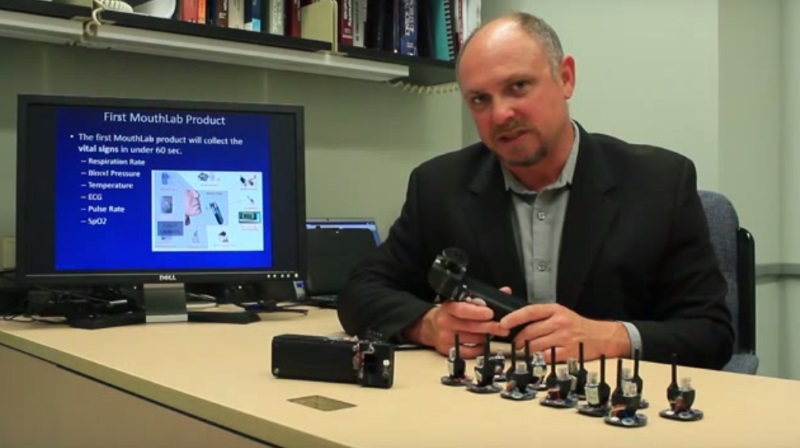- Home
- Science
- Science News
- Handheld, 3D Printed Device to Read Vital Signs via Lips and Fingertips
Handheld, 3D-Printed Device to Read Vital Signs via Lips and Fingertips

Called MouthLab, the "smart" 3D-printed device uses mouthpiece and thumb pad sensors to quickly test a patient's blood pressure, breathing, blood oxygen, heart rate and heartbeat pattern.
The device can also take a basic electrocardiogram (ECG).
"We see it as a 'check-engine' light for humans. It can be used by people without special training at home or in the field," said the device's lead engineer Gene Fridman, assistant professor of biomedical engineering.
The device may be able to detect early signs of medical emergencies such as heart attacks or avoid unnecessary ambulance trips and emergency room visits when a patient's vital signs are good.
Because it monitors vital signs by mouth, future versions of the device will be able to detect chemical cues in blood, saliva and breath that act as markers for serious health conditions.
"We envision the detection of a wide range of disorders, from blood glucose levels for diabetics, to kidney failure, to oral, lung and breast cancers," Fridman emphasised.
The device can replace the bulky, restrictive monitors now used to display patients' vital signs in hospitals.
"It can gather more data than is typically collected during a medical assessment in an ambulance, emergency room, doctor's office or patient's home," ther authors noted.
The MouthLab prototype consists of a small, flexible mouthpiece like those that scuba divers use, connected to a handheld unit about the size of a telephone receiver.
The mouthpiece holds a temperature sensor and a blood volume sensor.
The thumb pad on the handheld unit has a miniaturised pulse oximeter a smaller version of the finger-gripping device used in hospitals, which uses beams of light to measure blood oxygen levels.
Other sensors measure breathing from the nose and mouth.
The hand unit relays data by Wi-Fi to a nearby laptop or smart device, where graphs display real-time results.
"The next generation of the device will display its own data readouts with no need for a laptop," Fridman informed.
Ultimately, patients will be able to send results to their doctors via cellphone, and an app will let physicians add them to patients' electronic medical records.
"The goal is to obtain all vital signs in under 10 seconds," the authors noted in a paper published in the journal Annals of Biomedical Engineering.
For the latest tech news and reviews, follow Gadgets 360 on X, Facebook, WhatsApp, Threads and Google News. For the latest videos on gadgets and tech, subscribe to our YouTube channel. If you want to know everything about top influencers, follow our in-house Who'sThat360 on Instagram and YouTube.
Related Stories
- Galaxy S24 Series
- MWC 2024
- Apple Vision Pro
- Oneplus 12
- iPhone 14
- Apple iPhone 15
- OnePlus Nord CE 3 Lite 5G
- iPhone 13
- Xiaomi 14 Pro
- Oppo Find N3
- Tecno Spark Go (2023)
- Realme V30
- Best Phones Under 25000
- Samsung Galaxy S24 Series
- Cryptocurrency
- iQoo 12
- Samsung Galaxy S24 Ultra
- Giottus
- Samsung Galaxy Z Flip 5
- Apple 'Scary Fast'
- Housefull 5
- GoPro Hero 12 Black Review
- Invincible Season 2
- JioGlass
- HD Ready TV
- Laptop Under 50000
- Smartwatch Under 10000
- Latest Mobile Phones
- Compare Phones
- Huawei Pura 70 Pro
- Huawei Pura 70
- Vivo V30e
- Itel Super Guru 4G
- Huawei Pura 70 Pro+
- Huawei Pura 70 Ultra
- Tecno Camon 30 Premier 5G
- Motorola Edge 50 Fusion
- Asus ZenBook Duo 2024 (UX8406)
- Dell Inspiron 14 Plus
- Realme Pad 2 Wi-Fi
- Redmi Pad Pro
- Cult Shock X
- Fire-Boltt Oracle
- Samsung Samsung Neo QLED 8K Smart TV QN800D
- Samsung Neo QLED 4K Smart TV (QN90D)
- Sony PlayStation 5 Slim Digital Edition
- Sony PlayStation 5 Slim
- Voltas 1.5 Ton 3 Star Split AC (183 Vectra Elegant 4503545)
- Hitachi 1.5 Ton 5 Star Inverter Split AC (RAS.G518PCBISF)

















